
In a manuscript from Lucas d’Heere entitled Theatre de tous les peuples et nations de la terre avec leurs habits, et ornemens divers, tant anciens que modernes (c. 1576), a remarkable figure appears: a man wearing a long black habit and a black hood, identified as ‘Doeuil d’Europe‘ (‘Mourning of Europe’).[1] In contrast to the other characters in d’Heere’s costume book, this faceless creature is not defined as human. Rather, it embodies a more general concept of the outward expression of bereavement. The pendant of this image is a ‘Bourgeois d’Europe‘. Although this is also an uncharacteristically indistinct label, the ‘Bourgeois d’Europe‘ looks more like a man of flesh and blood wearing a short black cape and bright yellow pants and hose. He is facing the mourning figure and seems to plead with him, albeit vainly [Figure 1].
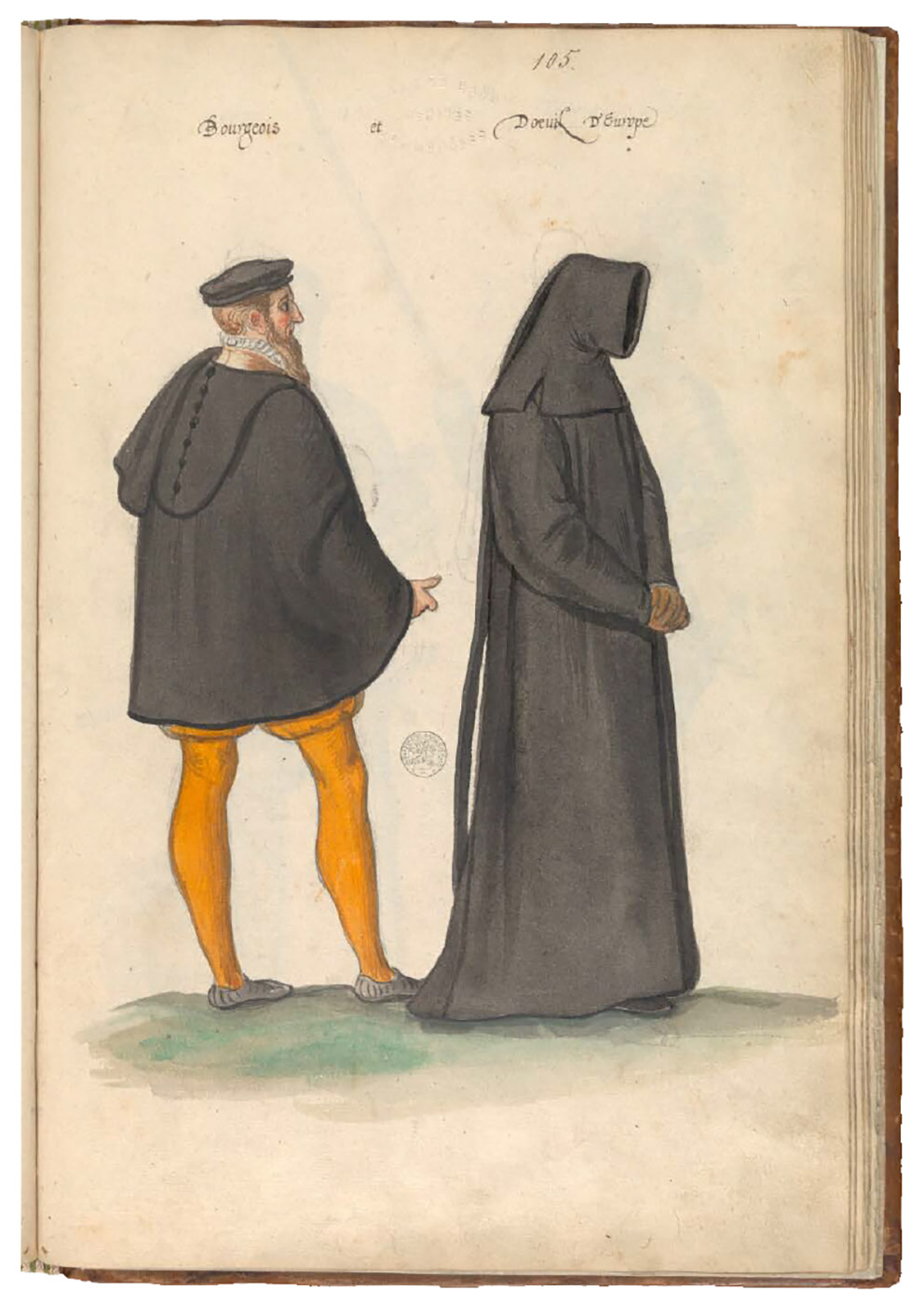
https://lib.ugent.be/catalog/rug01%3A000794288/items/910000094764
D’Heere did not invent these figures; they were based on plates in François Desprez’s popular costume book entitled Recueil de la diversité des habits, qui sont de present en usage, tant es pays d’Europe, Asie, Affrique et Isles sauvages, first printed in 1562 and reprinted several times.[2] D’Heere’s ‘Bourgeois d’Europe‘ is derived from Desprez’s ‘Lartisan Françoys‘ (‘The French artisan’). However, Desprez did not refer to a wider European context, nor to any relation with the plate of ‘Le dueil‘. Desprez presents ‘Le dueil‘ as an isolated figure, and adds the following subscriptio, underlining the ceremonial function of black funeral dress and the ritualized expression of grief that goes with it [Figure 2]:
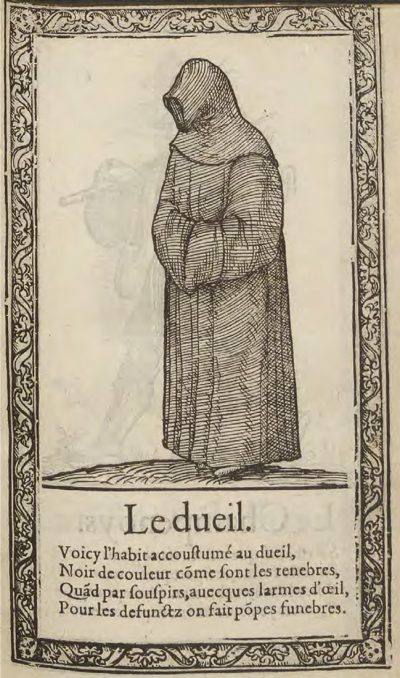
Voicy l’habit accoustumé au dueil,
Noir de couleur comme sont les tenebres,
Quand par souspirs, avecques larmes d’oeil,
Pour les defunctz on fait pompes funebres.Here is the habit accustomed for mourning,
Black in colour as is the darkness,
When with sighs and tears of the eye,
For the dead we have funeral rites.
Explanatory captions are entirely absent from d’Heere’s manuscript. Still, d’Heere did not mechanically copy Desprez’s image. In particular, he enhanced the aristocratic appearance of ‘Doeuil d’Europe‘ by adding a characteristic liripipe or long tail to the hood.[3]
Despite his elusiveness, the black-hooded mourner can usher us along the cultural experiences and evolving worldviews of the sixteenth-century painter, poet, and propagandist d’Heere. During his education and training as an artist, d’Heere had been immersed in a noble funeral culture that revolved around theatrical burial monuments, ceremonies, and dress. This solemn aristocratic world was literally shrouded in black fabric. D’Heere’s conversion to Protestantism and his exile to England had brought him dark days in both metaphorical and sartorial senses. In the Theatre de tous les peuples et nations de la terre, d’Heere tried to imbue his unstable world with a sense of order by plunging into the emerging discipline of ethnography, which then categorized humans on the basis of the regional or ceremonial costumes they wore. Although not apparent at first sight, close reading reveals that the Theatre was also a commentary on contemporary political affairs. Hence, ‘Doeuil d’Europe‘, I will suggest, is a moral reflection on the mournful state of Europe, torn by religious wars, and therefore no longer confidently presiding over the other continents.
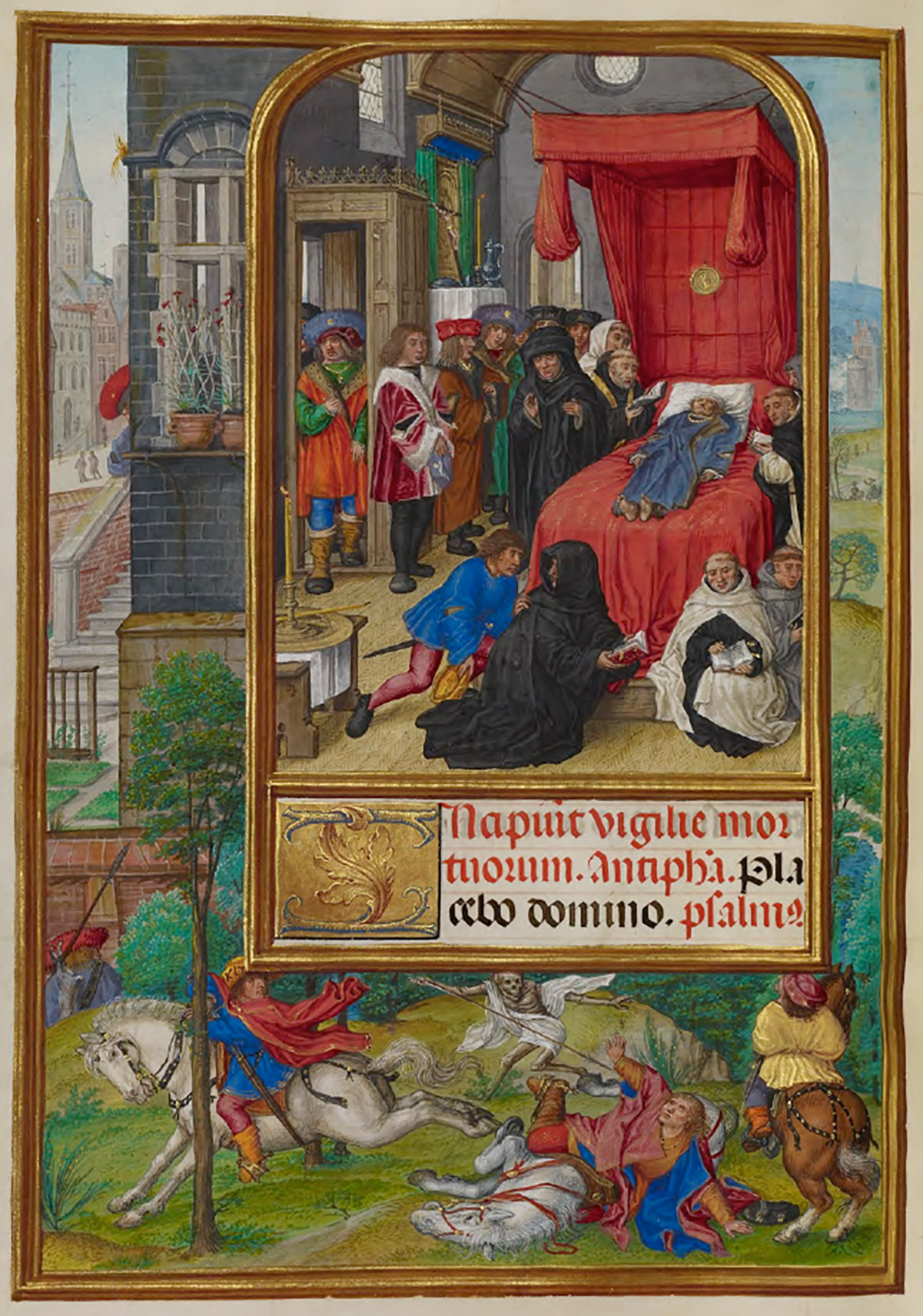

Obsequies
Lucas d’Heere (1534-1584) was born in Ghent. Both his parents were respected artists. His father, Jan d’Heere, was a sculptor and architect, his mother, Anna de Smytere, an accomplished miniature painter. He was trained as a painter and a designer of tapestries and stained glass windows in the Antwerp workshop of Frans Floris, an influential painter working all’antica. Mastering several specializations in this way was a quite common financial strategy in such sixteenth-century artist families. Meanwhile, the d’Heere family sought patrons in the same milieu of wealthy noblemen, prelates, and patricians.[4]
Lucas’s father Jan was a versatile artist, architect, and entrepreneur. One of his most lucrative crafts was undoubtedly the design and execution of funeral tombs and epitaphs for the elites. He began his career with one major project: the funeral monument for Isabella of Denmark (1501-1526), the tragic sister of Emperor Charles V. Isabella died from illness at the castle of Zwijnaarde near Ghent. Her royal husband, the exiled Christian II of Denmark (1481-1559), commissioned the building of a mausoleum in the nearby Benedictine abbey of St Peter. The execution of the design by early Renaissance artist Jan Gossart was assigned to local sculptor Jan de Smytere, but when the latter died in 1528, his pupil Jan d’Heere — originally from Mechelen — finished the monument.[5]
During his subsequent, long career in Ghent — sealed by his marriage with Jan de Smytere’s talented daughter Anna — Jan d’Heere designed and executed the tombs of powerful prelates such as the abbot of St Peter and the two consecutive mitred provosts of the cathedral of St Bavo, in addition to a number of epitaphs for local noblemen and patricians. Due to two waves of iconoclasm in Ghent in the second half of the sixteenth century, his oeuvre is lost almost completely.[6] Still, Jan d’Heere was admired immensely by his contemporaries, and he was able to befriend Frans Floris’s brother Cornelis Floris de Vriendt, whose inventive freestanding burial monuments all’antica were in vogue with the ruling elites of Europe.[7]
Funeral monuments could also be commissioned during life. They offered a lasting stone memorial to a person of rank, firmly placing him or her within a matrix of religious faith, genealogy, and personal status. These considerations of rank and file also required elaborate funeral rites.[8] A well-documented example took place at the occasion of the burial of high Burgundian noble Adolf of Cleves, lord of Ravenstein (d. 1492). His tomb in the Dominican church in Brussels no longer survives, but we have a detailed description of his funeral ceremony, which lasted several days and included processions with clergy, heralds, relatives and servants, a string of masses, and the offering at the altar of Ravenstein’s jousting shields, tournament helmet, warhorse, and sword.[9]
The colour black was omnipresent during these mourning rites. Ravenstein’s body was transported on a cart, covered in black and drawn by four horses, which were also shrouded in black. The church was draped in black cloth, decorated with blazons of Ravenstein’s coat of arms. The walls and floors of the lord’s residence were also completely covered in black, and so was his bed, at the foot of which his widow was to be seated on a black cushion [Figure 3-4]. Close relatives and friends accompanied the procession, wearing mourners’ dress, with black hood and cloak.[10] These characteristic pleurants also appear in stone form in contemporary burial monuments, such as the mourners executed in black stone for the tomb of the Burgundian high official Philippe Pot (d. 1493) [Figure 5].[11]
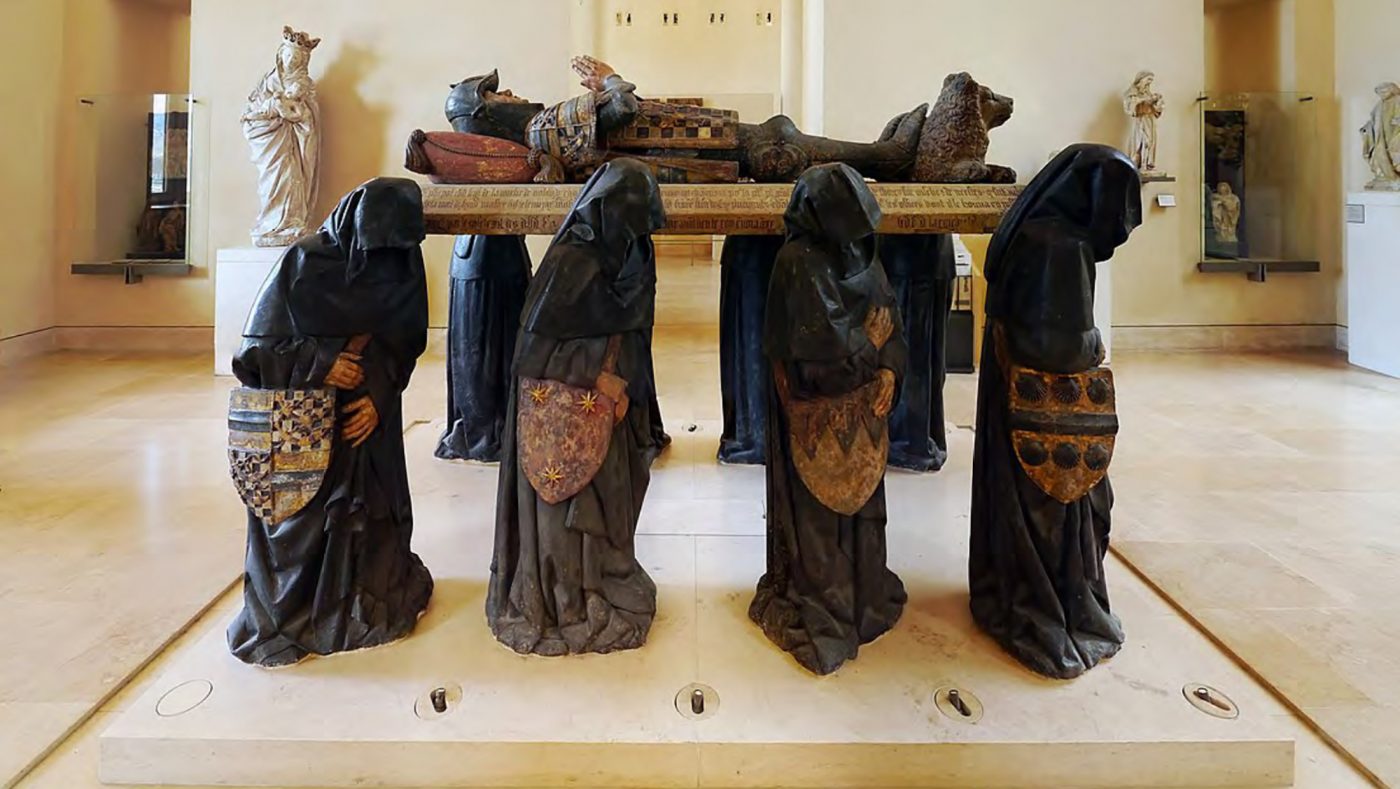
Although mourning dress was intended to express a detachment from earthly vanities, social status was communicated by the quality or the quantity of the cloth. The higher the status, the richer the fabric and the longer the dress, which was sometimes accentuated by a long train. Hoods worn over the face were only allowed for the noble relatives and servants of the deceased.[12] This was already the case around 1400 at the courts of the Counts of Flanders and the Dukes of Brabant.[13] It was long believed that the Burgundian Duke Philip the Good (1396-1467) popularized mourning in black amongst the nobility, after having worn no other colour following the assassination of his father John the Fearless (1371-1419). In fact, Philip’s preference for black was the result of a mixture of fashion sensibilities and political concerns. His fine black garb was a far cry from the heavy woolen dresses of the pleurants.[14] Yet, as both a colour of reigning and of mourning, the Burgundian black soon caught on in other European courts. (See the essays by Jolivet and Hohti Erichsen elsewhere in this collection).[15]
The Habsburg dynasty that ruled the Low Countries from the late fifteenth century onwards continued the rich Burgundian tradition of mourning. The apogee was the series of obsequies organised in 1558-1559 across the Empire and the Spanish lands for Emperor Charles V (1500-1558). King Philip II (1527-1598) in particular was keen on having funeral rites for his father in regions as diverse as the Low Countries, Spain, Italy, and Mexico. While the body of Charles V remained buried in the monastery of Yuste in Spain, a lavish ceremony was held in Brussels in the presence of Philip II, who assumed the role of chief mourner. A long procession with representatives from Charles’s many lands and an allegorical ship of state progressed from the residential palace to the collegial church of St Gudule. Both edifices and the processional route were draped in black mourning cloth. Citizens in black gowns stood along the route, holding candles. In the church of St Gudule, the empty coffin was placed under an impressive chapelle ardente. The structure was decorated with the regalia and coats of arms of the deceased emperor and was lit by 3000 burning candles [Figure 6]. Philip II, accompanied by his knights of the Order of the Golden Fleece, was dressed in a black mourning cloak with a hood and a long train, carried by a noble servant [Figure 7]. At the end of the church ceremony, Philip took off his hood in a dramatic gesture which signified that, although Charles V had died, the body politic was still alive, and he was therefore his father’s rightful successor.[16]

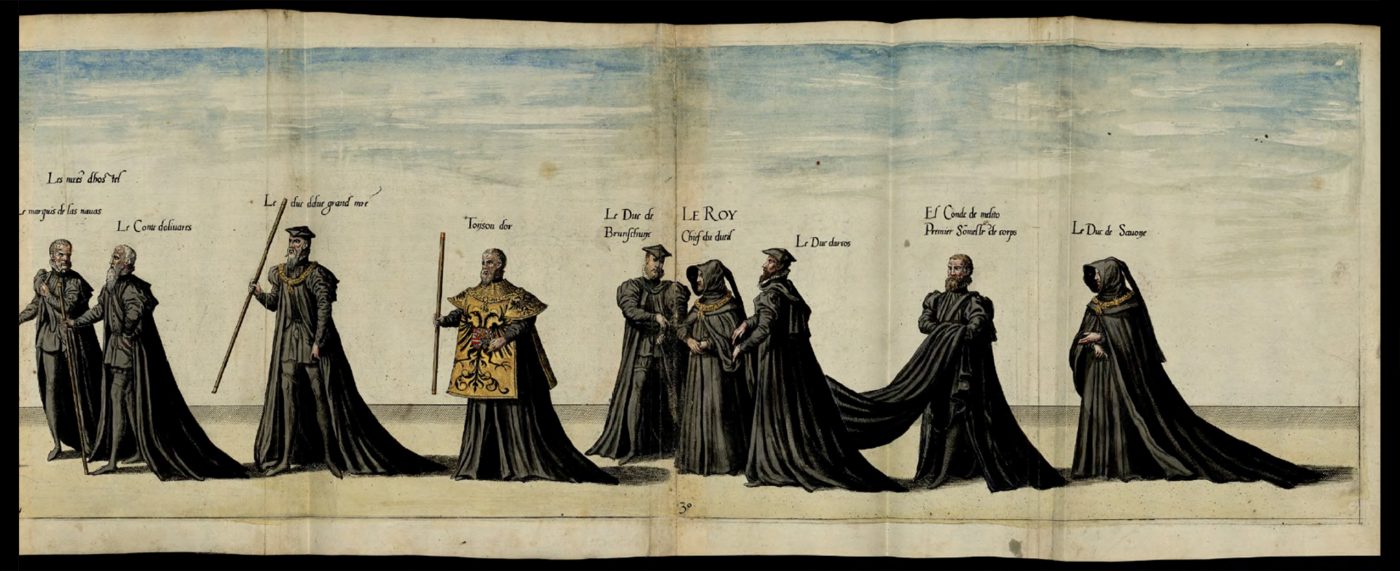
In 1559, Christophe Plantin’s Antwerp printing house published La magnifique et sumtueuse pompe funèbre faite… aux obsèques de l’empereur Charles V de tresdigne mémoire. It consisted of a number of fold-out prints designed by Hieronymus Cock and engraved by Joannes and Lucas van Doetechum, which together reconstructed Charles V’s funeral procession in Brussels. This widely spread publication — there were also editions in Dutch, Spanish, Italian, and German — was a response to the broad fascination for the funeral splendour of the ruling elites.[17] The book may well have inspired d’Heere in his update of François Desprez’s mourning figure. Although the costume of ‘Doeuil d’Europe‘ lacks the royal grandeur of Philip II’s mourning dress, the small train and long liripipe signal the wearer’s aristocratic status.
In all likelihood, d’Heere had also been a privileged witness of a number of noble funeral ceremonies in Ghent, including that of Lucas Munich, mitred provost of the cathedral chapter of St Bavo, in 1563. Lucas’s father Jan had been working on the tomb of the prelate, which was still unfinished at the time of the latter’s decease.[18] An account of the expenses for Munich’s mourning lists a great quantity of fabrics, predominantly black, intended for the decoration of the cathedral of St Bavo, the provost’s residence in Ghent and the chapel of the castle of Lochristi near Ghent ‘daer ‘t lichaem van wijlent ons eerwerdighe heere rustende es’ (‘where the body of our late reverent lord is resting’). In addition to curtains, altar cloths, and shrouds, the account lists the purchase of black clerical garb such as tunicles, chasubles, and copes. Finer black fabrics were either purchased or rented.[19]
While it is unknown whether he played an active role in the mitred provost’s funeral rites, d’Heere had effectively mastered the visual language of mourning, including particularly significant decorations for the chapter of the Order of the Golden Fleece in the church of St Bavo in 1559.[20] Duke Philip the Good had instituted the Order of the Golden Fleece in 1430 to promote the unity and Christian foundation of the Burgundian lands. Every few years, the Order’s high noble knights gathered in one of the major cities of the realm. The corresponding religious ceremonies were held in the host town’s main church.[21] In 1559, Jan d’Heere commanded a large workforce and acted as the chief master artisan responsible for the rearrangement of the choir of the church of St Bavo, which included the building of a monumental choir screen. Twenty-five-year-old Lucas made large canvas paintings with representations of biblical scenes to embellish it. One of these paintings, representing the visit of the Queen of Sheba to King Solomon — the latter with the features of King Philip II — is still extant.[22]
The religious ceremonies of the Order of the Golden Fleece were strictly choreographed by the noble herald Toison d’Or, and made ample use of rituals and imagery borrowed from funereal culture. In Ghent in 1559, this was a fortiori the case. The opening of the chapter had to be postponed for a fortnight because of the unexpected death in tournament of King Henry II of France, Philip II’s brand new father in law. Royal decorum required a proper memorial service for the French king, which was held in Ghent’s parish church of St Michael and was attended by Philip II and the knights of the Golden Fleece, all in black mourning dress. The church interior was covered in black cloth, adorned with French lilies. Heralds held the coats of arms of France. In a chapelle ardente stood a bier, on which a golden crown and sceptre were placed. Burning candles filled the entire church.[23]
The commemoration of the dead had always been central to the rites of the Order of the Golden Fleece. On the three consecutive days of the chapter, the knights paraded to the church, where they attended elaborate masses in the choir. These three days were devoted to St Andrew (the patron saint of the Burgundian dynasty), the memory of the knights deceased since the previous chapter, and the Virgin Mary, respectively. The colour of dress changed accordingly: crimson, black, and white [Figure 8].[24] There was an immense reverence for these vestimentary traditions instituted by Duke Philip the Good. While according to custom, a chapter of the Golden Fleece was organized around the feast day of St Andrew (i.e. on November 30), in 1559, the meeting was held during summer. Only after much consideration, King Philip II decided that black velvet would substitute black cloth in the customary funeral dress, since this prevented the knights from suffering too much from the hot summer weather. In every other respect, the core rituals of the Order of the Golden Fleece had remained immutable since their institution in the fifteenth century.[25]
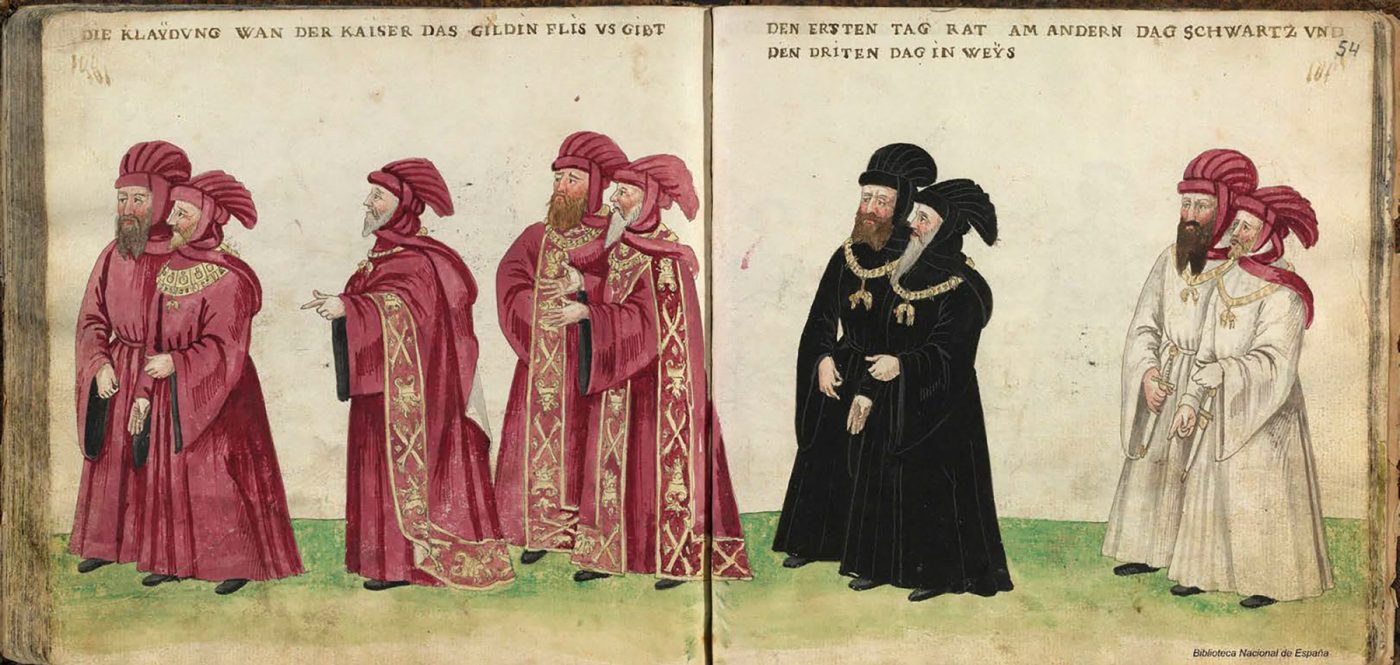
During the religious services of the chapter of the Golden Fleece, both colour schemes and ritual acts emphasized the cult of the dead. The knights were seated on canopied choir stalls, which were richly decorated with red cloth for the living knights and black cloth for the empty seats of the deceased. During the requiem mass on the second day of the chapter, each knight, dressed in black mourning, was provided with a wax candle with his coat of arms. He was then invited, in order of precedence, to the offertory to offer up his candle. The knights deceased since the previous chapter were also called up, but when they did not respond their candles were extinguished. The two larger candles for Charles V and Philip II, old and new grandmasters of the Order, were handled in a similar fashion. Indeed, the candle ritual was extraordinarily meaningful in 1559, since the chapter of Ghent was conceived as the ceremonial farewell of Charles V from the Order, in this way prolonging the obsequies held in Brussels in 1558.[26]
Theatre
Both Lucas and his father Jan d’Heere enjoyed the artistic patronage of powerful men with ties to the Burgundian-Habsburg court, particularly the consecutive mitred provosts of St Bavo, Lucas Munich (1490-1563) and Viglius ab Aytta (1507-1577). D’Heere also established himself as a well appreciated and well-connected poet in Ghent. In 1565 he published Den hof en boomgaerd der poesien, which contains a mixture of sonnets — a new genre in Dutch literature at the time — and more traditional ballads. The poems were dedicated to a wide group of friends and patrons, both Catholic and Protestant. His own growing interest in Reformed theology becomes apparent from the publication, in 1565, of a psalm translation, entitled Psalmen Davids. Gradually, he was cutting himself loose from his comfortable position as an artist in the service of a wealthy clientele, which had been noble, conspicuously Catholic, and pro-Habsburg. Shortly after the first wave of iconoclasm in Ghent in 1566 and the consequent repression of Reformation sympathizers by Catholic authorities, he fled to England, a popular safe haven for Protestants from the Low Countries at the time.[27]
In England, thanks to the popularity of Flemish artists, d’Heere quickly established a new career in the service of the country’s Protestant nobility, now mainly as a portrait painter. He also continued his literary activities, both in French and in Dutch. He composed a Tableau poétique for his new patron Edward Seymour, the Earl of Hertford (1539-1621), and wrote a geographical and historical description of England, Scotland, and Ireland aimed at Flemish merchants. Like many refugees, and despite his professional success and wide intellectual network, d’Heere’s religious and political convictions hardened. As an elder within the Dutch Reformed refugee community in London, he became a prominent figure in the milieu of exiled Calvinists. Because of his access to important English courtiers, William of Orange (1533-1584) and Philips of Marnix of Saint-Aldegonde (1540-1598) soon engaged him as a diplomat for the cause of the Dutch Revolt. In 1577, d’Heere returned to the Low Countries, where he acted as chief propagandist of the Ghent Calvinist Republic (1577-1584), directing amongst others the entry ceremonies of William of Orange and of François d’Alençon, Duke of Anjou (1555-1584), who had been elected the new sovereign of the Low Countries by the States General.[28]
D’Heere’s poetry frequently refers to the insecurities of flight and the hardships of a life in exile. In a sonnet dedicated to his patron Edward Seymour in 1569, d’Heere uses painting colours as a metaphor for his spiritual regeneration in England.[29]
Et mon Carme quittant son triste et dur langage
Est maintenant tout gay de ioye environné
Comme aussi ma peinture, ayant abandonné
Ses trop mornes couleurs monstre son beau visage
And my song leaving its sad and hard tone
Sounds very gay now, surrounded by joy
As my painting also, having abandoned
Its too sombre colours, shows its pretty face
Colour was also one of the explicit points of interest in the costume book d’Heere compiled during these years. In the Theatre’s dedication to Anthony of Burgundy, Lord of Wakken (d. 1601), the author refers to ‘les habits divers, et les couleurs, dont ie vous offre en ce men beau Theatre touts les pourtraicts’ (‘the various costumes and the colours, of which I offer you all the portraits in this, my beautiful Theatre’).[30] Indeed, in one image, two figures are completely naked except for their colours: two fierce ancient Britons from Julius Caesar’s time, painted in blue patterns, are preparing for combat [Figure 9].

Rather than a carefully planned work, d’Heere’s Theatre de tous les peuples et nations de la terre is a collection of 98 hand-coloured drawings, presenting historical and contemporary dress from what was then considered to be the four known continents: Europe, Asia, Africa, and the Americas. Currently, the Theatre exists as a paper manuscript (c. 325 x 215 mm) of a total of 127 folios or 30 quires in a modern binding. The gouache drawings are executed on the recto pages. The manuscript opens with the coats of arms of Anthony of Burgundy and a dedication to this lord and it closes with a number of emblemata. D’Heere probably rearranged the drawings in a meaningful order after having completed most of them. The manuscript opens with the Biblical figure of Aaron, followed by costumes from ancient Rome, Italy, Germany, Switzerland, Friesland, Russia, Poland, the Low Countries, France, the British Isles, Portugal, and Spain. Subsequently, there is a section on the vestments of the Catholic hierarchy and the religious orders. The manuscript concludes with a more condensed portrayal of the costumes of the continents: six characters representing Europe, eighteen representing ‘Asia’ (more precisely, parts of the Middle East and Africa, including Turkey, Greece, Armenia, Egypt, and Persia), five representing Africa, and, finally, one Inuit man, who represents the New World.[31]

The genesis of this manuscript is particularly complex: judging from the watermarks, d’Heere compiled it before, during, and after his English exile, with the bulk of the images created around 1576, shortly before his return to the Low Countries. The compilation was originally dedicated to a knight of the English Order of the Garter, perhaps Edward Fiennes of Lincoln, Lord High Admiral (1512-1585). Yet, after his return to Ghent, d’Heere glued the coat of arms of his new patron Anthony of Burgundy over the first armorial. Some scholars have suggested that d’Heere’s friend Joris Hoefnagel made some of the more accomplished drawings, such as a lady and magnifico of Genoa, the latter with an impressive black tabard [Figure 11]. However, it seems more likely that d’Heere copied a number of Hoefnagel’s drawings, made during the latter’s Europe-wide travels. More generally, d’Heere used a wide variety of printed sources such as costume books, antiquarian compendiums and travel accounts. The drawings with costumes from the Low Countries and the British Isles are the most original: since d’Heere was familiar with these regions, he probably derived the historical figures from images in medieval manuscripts and from effigies on funeral monuments, while the contemporary costumes are at least partly based on his personal observations [Figure 10]. Only in one instance does the caption betray an explicitly political viewpoint: d’Heere labelled two Flemish fishermen as ‘Chastieurs des Espaignols‘ (‘Pursuers of the Spaniards’), a reference to the role of the Sea Beggars in the political conflict of the Dutch Revolt [Figure 12].[32]
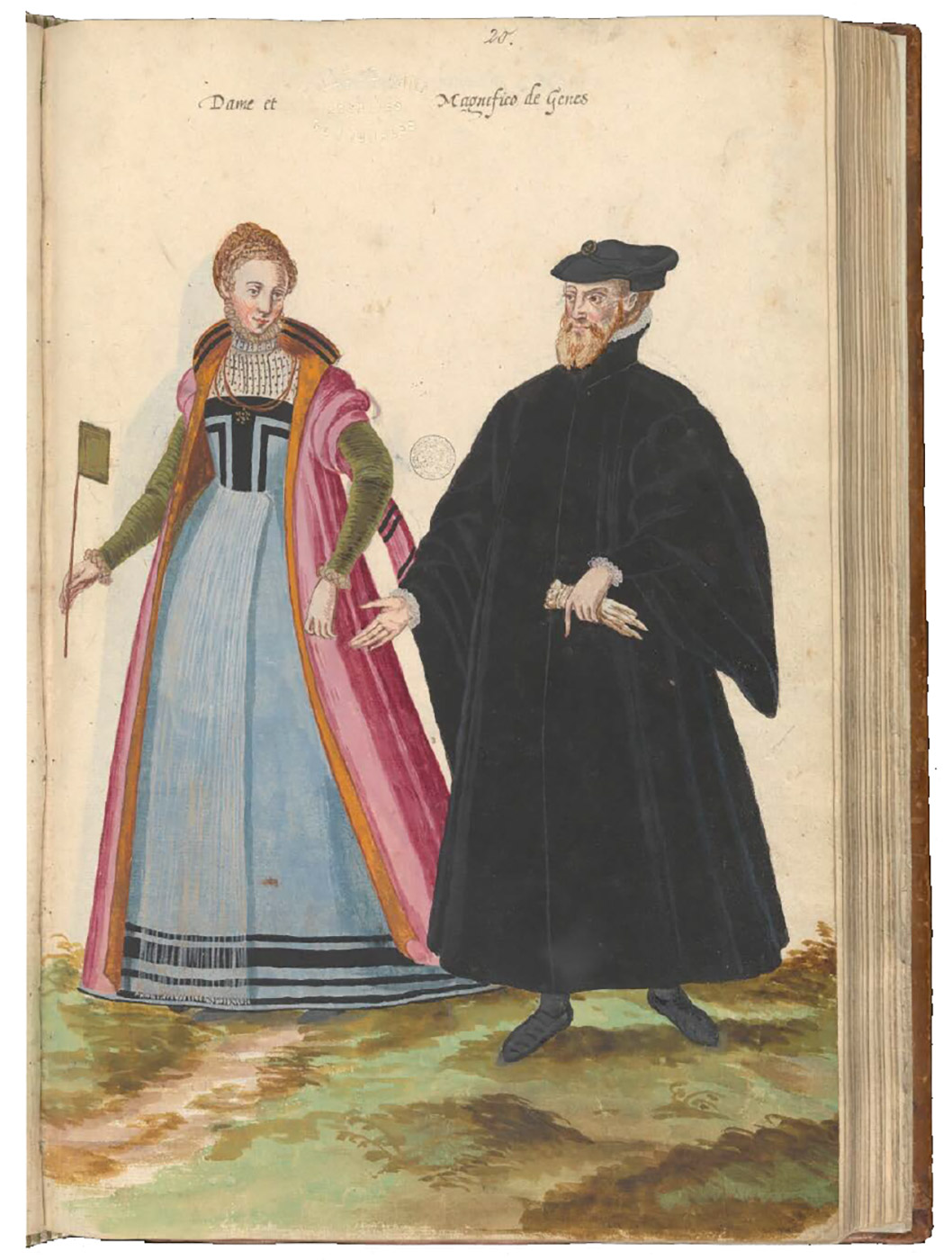
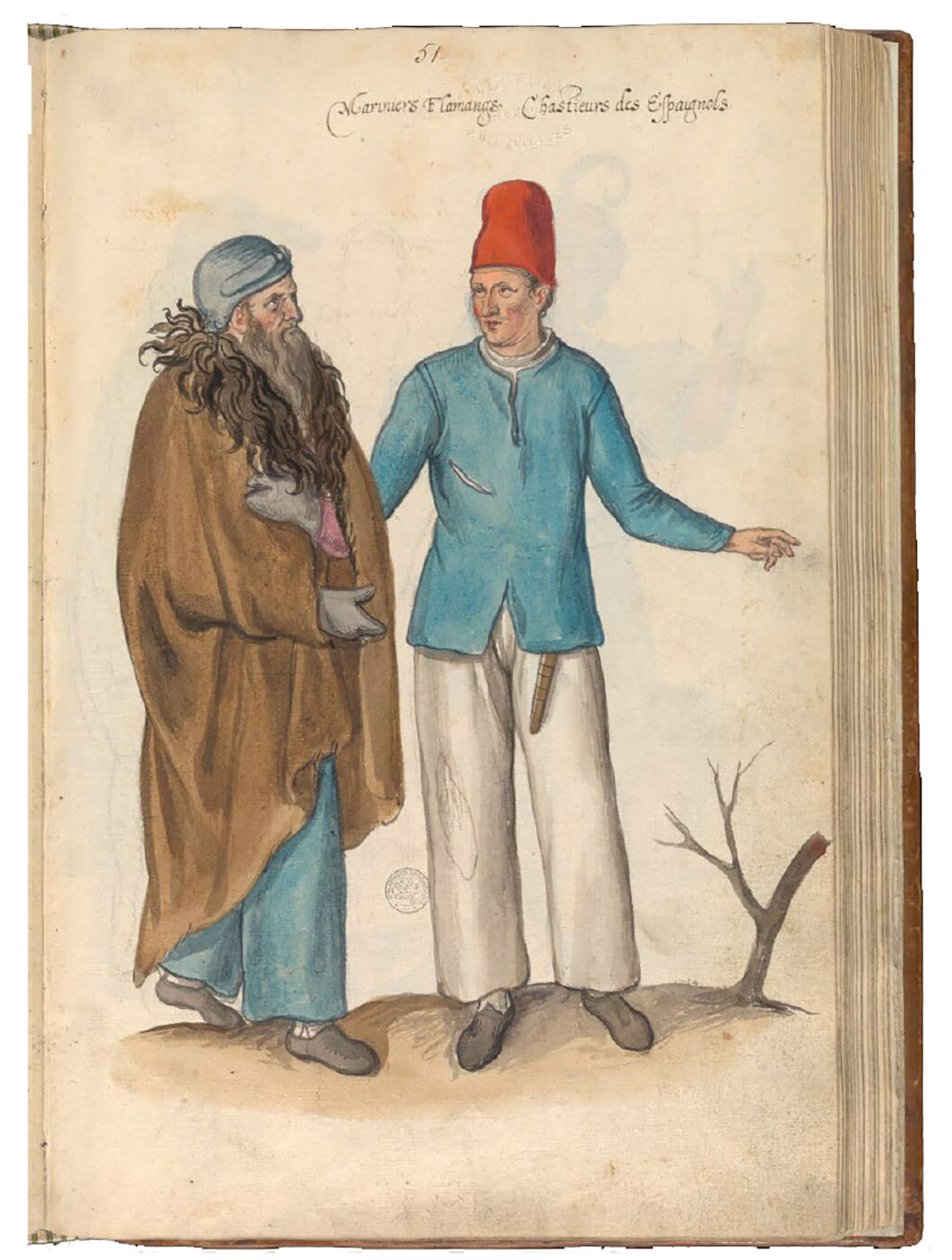
Sixteenth-century costume books played an important role in the early development of the disciplines of ethnography and — when they considered historical dress — antiquarianism. Since dress played such an essential role in the performance of social and cultural identities, costume was considered the defining characteristic of humans. The fact that ‘costume’ and ‘custom’ share the same linguistic roots is not a coincidence, while ‘habit’ also contains a double meaning.[33] This also explains the vivid interest in mourning dress, perhaps the most strictly regulated form of attire, which was embedded in a ritual universe of its own.[34] In fact, the Burgundian-style funerals with elaborate heraldic display and long parades of relatives, friends, and servants in black mourning attire were very much in vogue in late sixteenth-century England, obviously after having been stripped of their Catholic elements.[35] In the Theatre de tous les peuples et nations de la terre, apart from the enigmatic ‘Doeuil d’Europe‘, d’Heere depicts a Venetian widow, a French damsel in mourning, and a village lady in mourning [Figure 13]. The latter two are based on plates by Desprez, but were adapted and given more personal traits.[36] Interestingly, d’Heere did not reproduce Desprez’s sumptuously veiled ‘Le dueil de Flandre‘, perhaps because it did not correspond with his own observations [Figure 14].
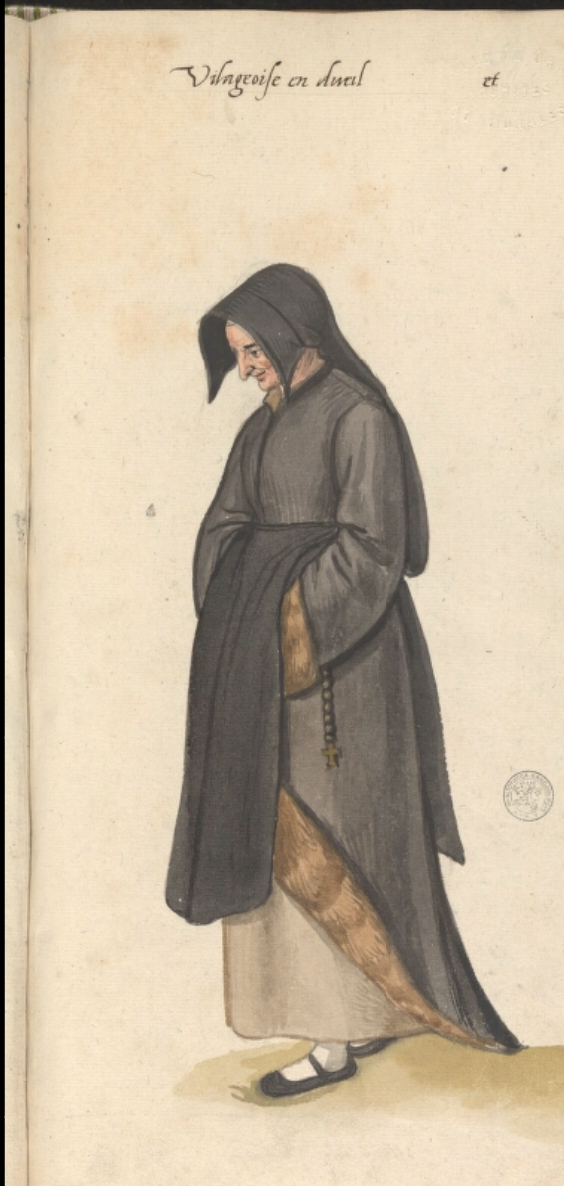
The emerging disciplines of ethnography, antiquarianism, history, and geography were still closely related at this moment. Humanists and artists tried to establish order within the tremendous volume of new knowledge about territories that Europeans had recently discovered and about Roman and local Antiquity. Collecting and describing — both textually and visually — were essential acts in understanding the world. Yet, the ruptures caused by the Reformation and the Europe-wide religious wars shattered this original optimism about the fruits to be reaped from these intellectual and creative endeavours. Many scholars and artists went into exile. The exodus of intelligentsia from the Low Countries was particularly significant. However, instead of abandoning their exploration of past and present civilizations, many actually intensified their quest for order in this chaos, even though doubts about the morality of human nature were rising.[37]
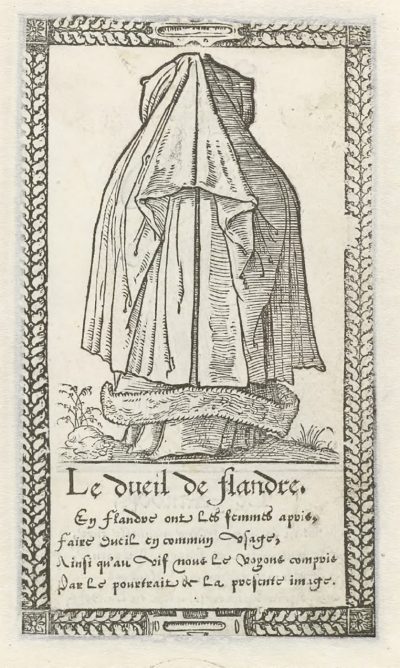
From this perspective, it is interesting to compare d’Heere’s Theatre with the Theatrum Orbis Terrarum, the first world atlas published in Antwerp in 1570 by his close friend Abraham Ortelius. The maps in the Theatrum Orbis Terrarum are accompanied by short descriptive texts on topography, local customs, and folklore. The intellectual parallels are clear: Ortelius staged the world through a sequence of maps; d’Heere did the same thing with costume. It is no coincidence that Ortelius and d’Heere both used ‘theatre’ in their titles. Referring to the Greek or Roman theatre, the theatrum was a metaphor that fitted the humanist desire to transmit new knowledge about the world in a visually attractive, ordered, and intellectually accessible manner. Yet, Ortelius’s atlas was a collective and commercial project that was conceived during the heyday of the Golden Age of Antwerp. Conversely, d’Heere’s Theatre was a personal manuscript, circulating within a small network of like-minded patrons and friends, of whom many had experienced exile.[38]
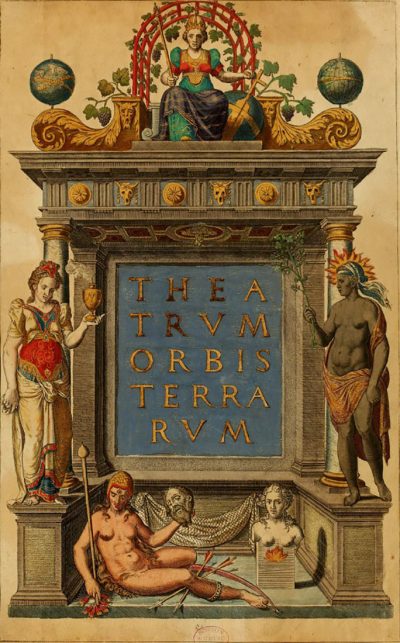
Both Ortelius and d’Heere were particularly interested in the representation of what they considered the four continents. The title page of the Theatrum Orbis Terrarum became an influential and even paradigmatic image, communicating the idea of the superiority of European civilization in a visually appealing, didactic, and even a slightly sensational manner [Figure 15]. It shows the four continents as female allegorical figures, hierarchically ordered in an antique portico. Europe is presiding on top, wearing a sceptre and crown. Below Europe, to her right side, Asia is standing, richly dressed, holding a jar of burning incense. She stands across from a half-naked black woman with a sprig of balsam in her hand, who signifies Africa. At the bottom of this hierarchy of continents, representing a European fantasy of barbarity, is America, a sensual naked white woman holding a wooden staff and a man’s head — a reference to the popular tales of cannibalism in the New World.[39]
D’Heere presents a similar sequence of continents (Europe, Asia, Africa, and America) in the Theatre de tous les peuples et nations de la terre, but his message is much more ambiguous. Except for two Turkish religious figures, all non-European figures are fully dressed, often with great splendour. One of the black-skinned Ethiopian figures is a Christian — Coptic — bishop [Figure 16]. The Inuit man representing America is described as an ‘homme sauvage’ or wild man, but in fact does not look very different from the simple Flemish fishermen. D’Heere probably drew this Inuit man from life, since the caption notes that he was brought to London in 1576 by explorer Martin Frobisher [Figure 17]. All these non-European characters seem more civilized than the primitive Anglo-Saxons portrayed earlier on in the manuscript. Thus, the Theatre de tous les peuples et nations de la terre presents a vision of human civilization that is more nuanced and relativistic, with Europe not necessarily on top of the world.[40]


It remains particularly strange that, after a colourful parade of historical and contemporary dress from most European regions and before introducing a number of equally diverse non-European characters, d’Heere deemed it necessary to insert six figures labelled as ‘European’ in a general sense. In fact, four are men of arms (including one jouster), both medieval and contemporary. The other two are the illusive ‘Bourgeois et Doeuil d’Europe‘, already familiar to us. Why did d’Heere select these particular images? I suggest that he deliberately included the figure of ‘Doeuil d’Europe‘ to make a statement to his circle of friends, who shared the same cultural references and political convictions, about the disastrous effects of the religious wars. One direct indication for this interpretation is a print published by Frans Hogenberg, depicting a tournament held between Spanish and Netherlandish noblemen on the Grand Place in Brussels in 1569 [Figure 18]. Some Spanish lords grew violent after their defeat. The caption on Hogenberg’s print leaves little doubt about its anti-Spanish message: by publicly jousting on the Grand Place, the Spanish had arrogantly demonstrated that the country was theirs. Jousting was a metaphor for the war in the Low Countries.[41]
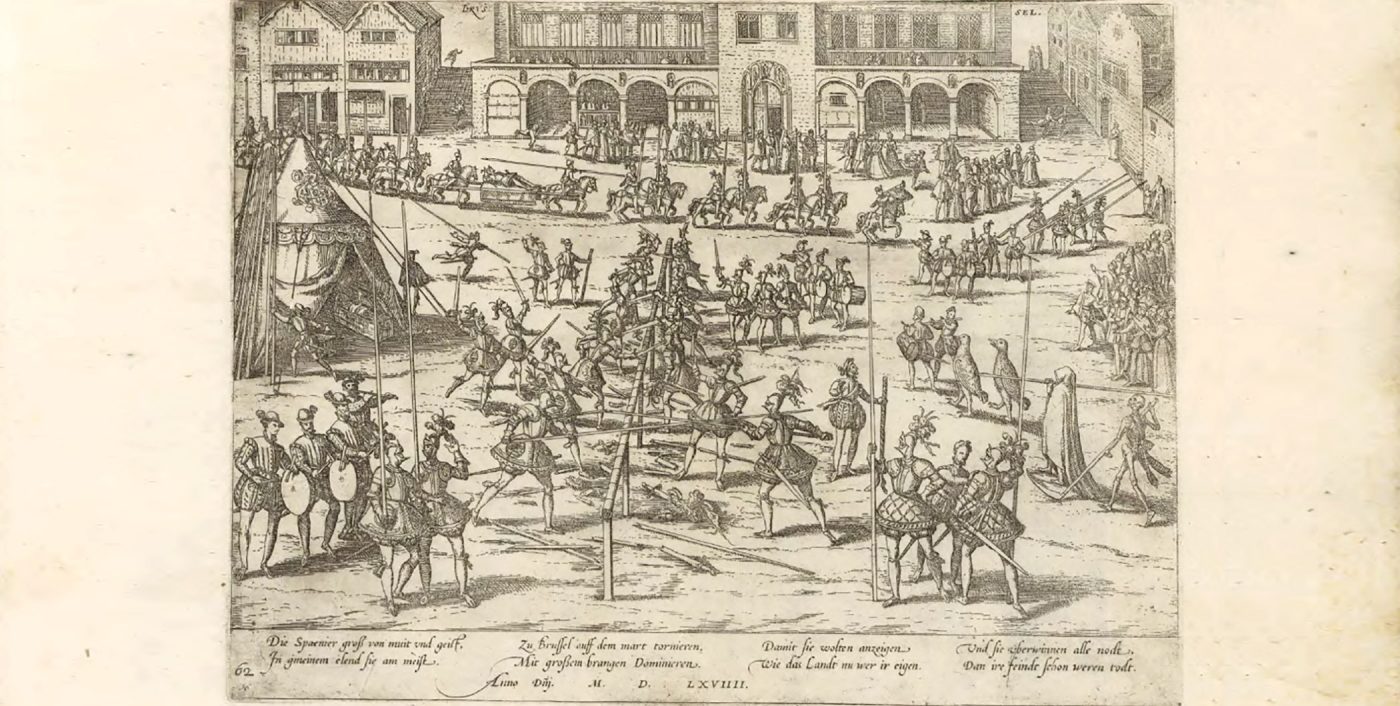
D’Heere based his drawing of the ‘Tournoieur d’Europe‘ (‘Jouster of Europe’) directly on this print [Figures 19 and 20]. Some of the bystanders — representing the local population — are dressed in the same fashion as the ‘Bourgeois d’Europe‘. The print also depicts a mourner, not identical but very similar to ‘Doeuil d’Europe‘ [Figure 21]. This particular scene has a surreal quality. The mourner carries a jousting lance in a mock funeral procession led by two musicians and two large birds. Presumably, these birds are parrots, referring to a popular derogatory term (‘papen‘) for the Catholic clergy. The Grim Reaper closes this small procession. This curious parade amplifies the message that Spanish warfare had sown death and destruction in the Low Countries.[42] At the same time, it is a counter-image to the grandiose obsequies for Charles V in the same city ten years earlier, which had ended the reign of a beloved ruler and had heralded the age of the contentious politics of his Spanish-born son Philip II.
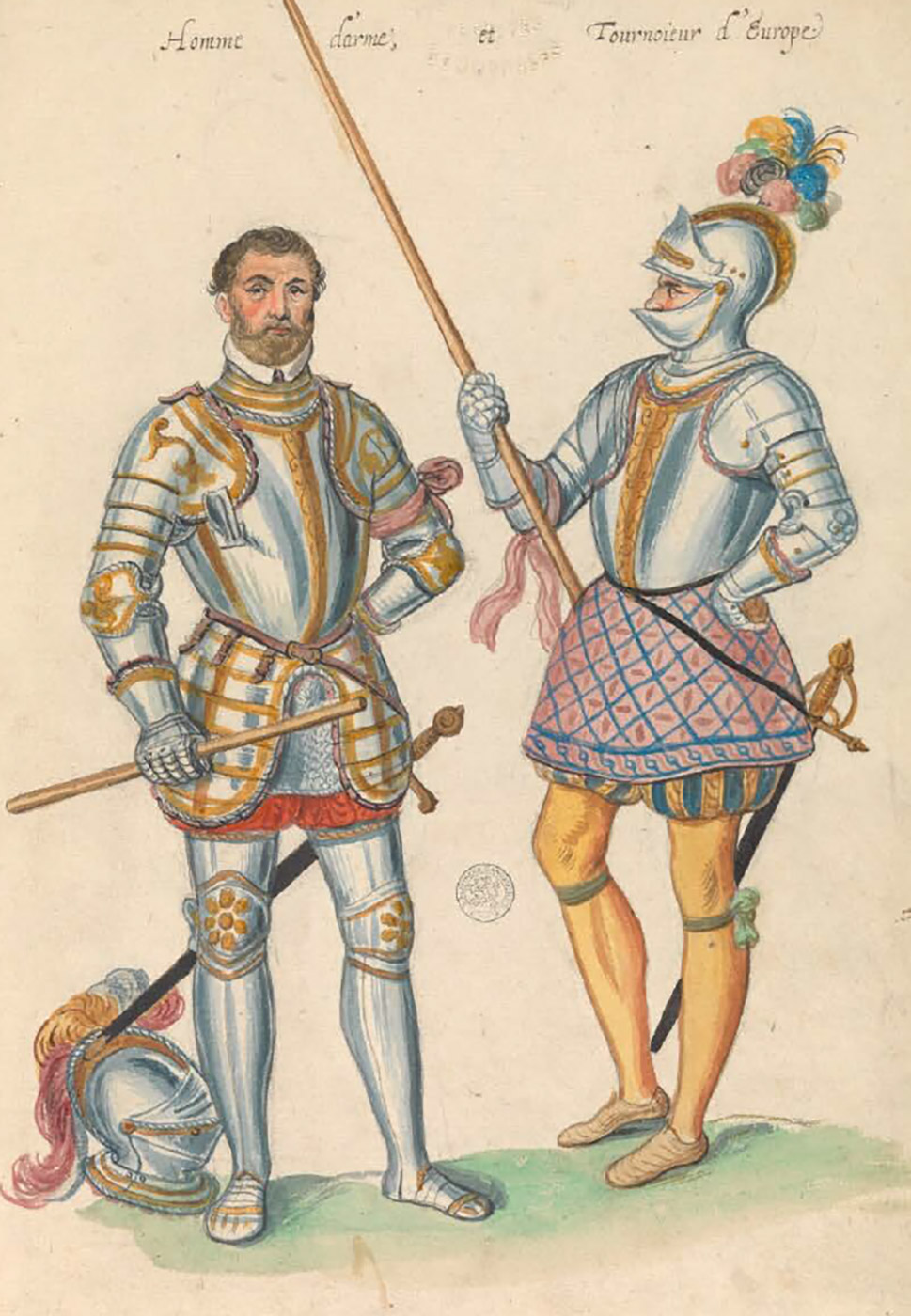
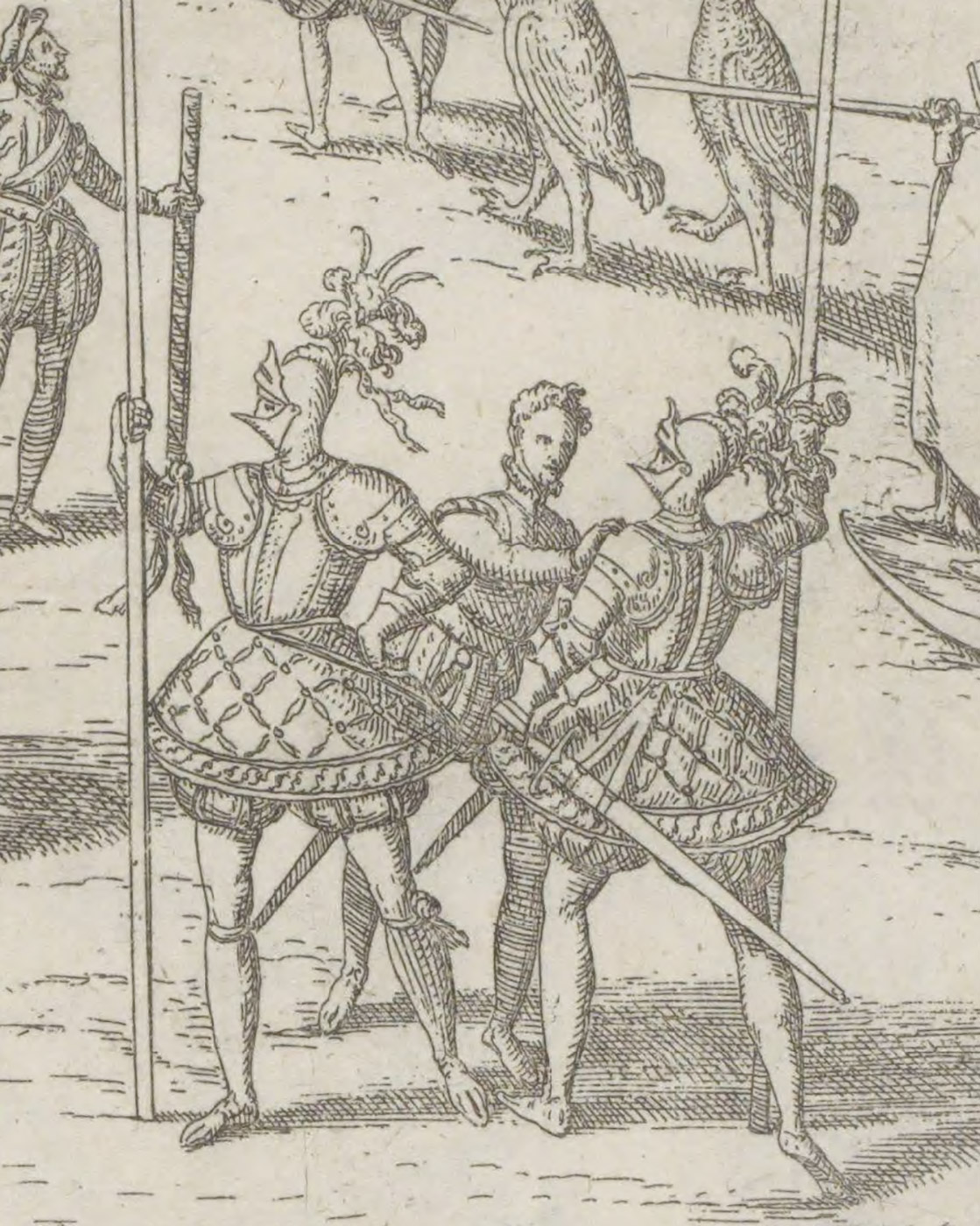
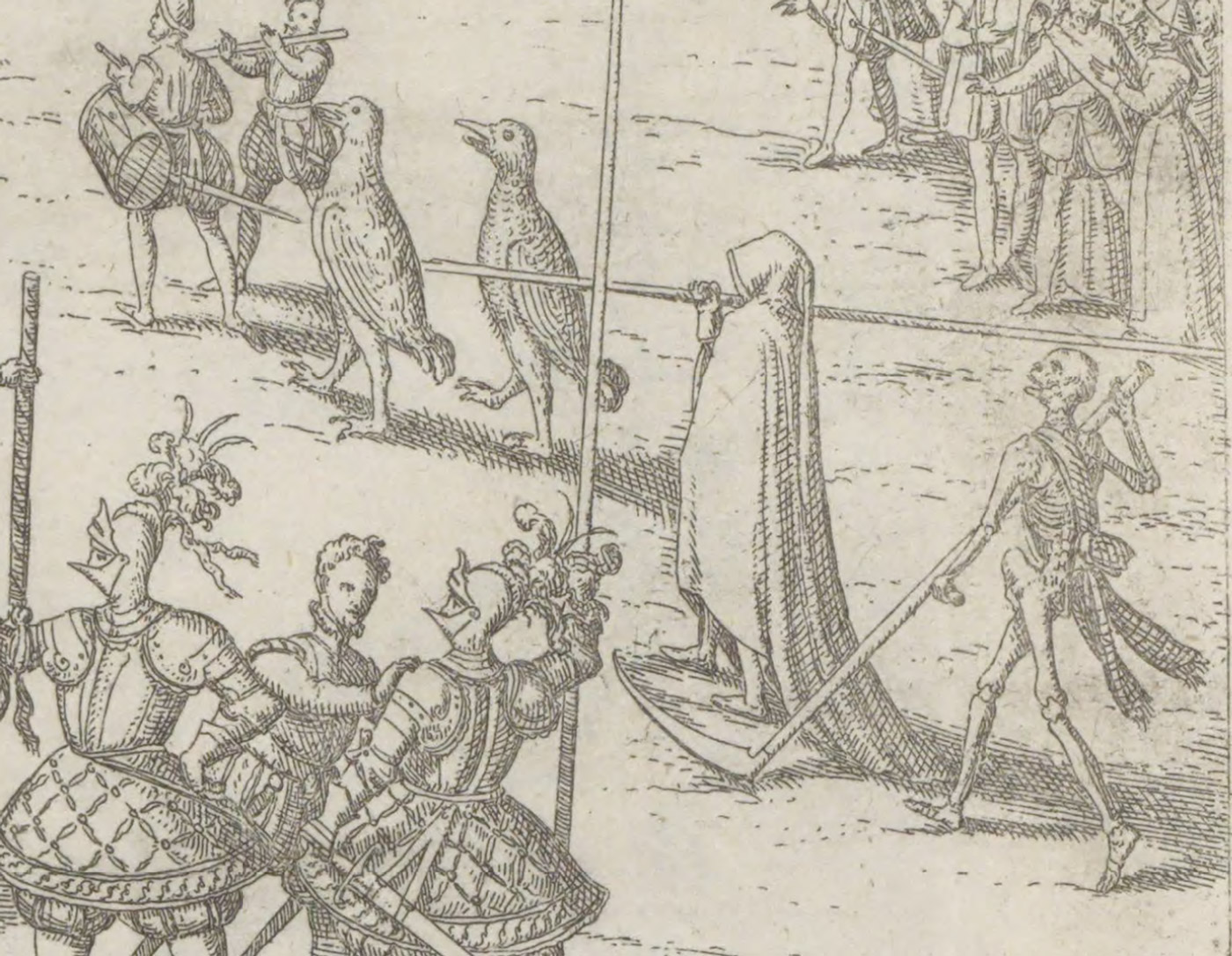
Envoi
In the Theatre de tous les peuples et nations de la terre, d’Heere depicts ‘the various costumes and the colours’ worn by the inhabitants of different continents and regions, both historically and in his own age. In this essay, I have emphasized the black-garbed and black-hooded figure of ‘Doeuil d’Europe‘ in order to make the point that these hand-coloured images can be read on different levels. Most obviously, ‘Doeuil d’Europe‘ is an ethnographic representation of black mourning dress as worn during the splendid funeral ceremonies of the sixteenth-century aristocratic elites. European funeral attire drew as much attention from early ethnographers as, for example, the dress of an Ethiopian bishop, because it belonged to an equally fascinating universe of socially regulated and ritually embedded costume. Essentially, the portrayal of different types of dress told a visual story about the texture of human culture.
Still, it would be dangerous to uncritically use images from costume books for a history of early modern dress. This certainly holds true for the Theatre, which was a private manuscript inextricably linked with its maker’s turbulent life path and worldview. ‘Doeuil d’Europe‘, in particular, has other, less obvious layers of meaning, and it expresses d’Heere’s professional familiarity with the ritual universe of mourning. His father specialized in the design of funeral monuments and he himself contributed to funeral or commemoration ceremonies, in the Low Countries and perhaps also in England. Finally, the faceless mourning figure in the Theatre presents us with a moral reflection. Implicitly referring to well-known festive and political prints, ‘Doeuil d’Europe‘ allegorizes d’Heere’s personal experiences with religious persecution and exile and, by doing so, reframes the war in the Low Countries as a European tragedy. In the end, the black mourner of Europe alerts the viewer to what d’Heere had learned the hard way: culture and civilization are relative and fragile things.
Bibliography
Bass, Marisa Anne. Insect Artifice. Nature and Art in the Dutch Revolt (Princeton: Princeton University Press, 2019).
Bond, Katherine. “Mapping Culture in the Habsburg Empire: Fashioning a Costume Book in the Court of Charles V,” Renaissance Quarterly 71 (2018), 530–579.
Chatenet, Monique. “Quelques aspects des funérailles nobiliaires au XVIe siècle,” in Les funérailles à la Renaissance, ed. Jean Balsamo (Genève: Librairie Droz, 2002), 37–54.
Conrads, Marian. “Het Theatre van Lucas d’Heere. Een kostuumhistorisch onderzoek.” PhD diss, Utrecht University, 2006.
Derolez, Albert. “Aantekeningen omtrent structuur, datering en betekenis van het kostuumboek van Lucas d’Heere (Gent, Universiteitsbibliotheek, hs. 2466),” in Handelingen van het XXIXe Vlaams Filologencongres, 16-18 april 1973 (S.l.: s.n., 1973), 261–271.
Fillitz, Hermann. Schatten van het Gulden Vlies (Brussels: Gemeentekrediet van België, 1987).
Gaudio, Michael. “The Truth in Clothing: The Costume Studies of John White and Lucas de Heere,” in European Visions: American Voices, ed. Kim Sloan (London: British Museum, 2009), 24–32.
Groebner, Valentin. “Inside Out: Clothes, Dissimulation, and the Arts of Accounting in the Autobiography of Matthäus Schwarz, 1496–1574,” Representations 66 (1999), 101.
Gruben, Françoise de. Les chapitres de la Toison d’Or à l’époque bourguignonne (1430–1477) (Leuven: Leuven University Press, 1997).
Jolivet, Sophie. “La construction d’une image: Philippe le Bon et le noir (1419–1467),” Apparence(s) 6 (2015), consulted 16.11.2019, https://journals.openedition.org/apparences/1307.
Kavaler, Ethan Matt. “Being the Count of Nassau. Refiguring Identity in Space, Time and Stone.” Nederlands Kunsthistorische Jaarboek 46 (1995): 12-51.
—– . “Sixteenth-century Netherlandish Sculpture. A Recovery,” Nederlands Kunsthistorisch Jaarboek 67 (2017).
McGrath, Elizabeth. “Humanism, Allegorical Invention, and the Personification of the Continents,” in Concept, Design & Execution in Flemish Painting (1550–1700), ed. Hans Vlieghe, Arnout Balis and Carl Van de Velde (Turnhout: Brepols 2000), 43–71.
Meganck, Tine Luk. Erudite Eyes. Friendship, Art and Erudition in the Network of Abraham Ortelius (1527–1598) (Leiden: Brill, 2017).
—–. Pieter Bruegel the Elder, Fall of the Rebel Angels. Art, Knowledge and Politics on the Eve of the Dutch Revolt (Brussels: Royal Museum of Fine Arts of Belgium, 2014).
Mentges, Gabriele. “Fashion, Time and the Consumption of a Renaissance Man in Germany: The Costume Book of Matthäus Schwarz of Augsburg, 1496–1564,” Gender & History 14, no 3 (2002), 387.
Neumann, Elisabeth.“Imagining European Community on the Title Page of Ortelius’ Theatrum Orbis Terrarum (1570),” Word & Image 25, no 4 (2009), 427–442.
Onghena, M.J. “Heere…, de oude, Jan…, de, vooral beeldhouwer, ook steenhouwer, kleinsteker en architect,” in Nationaal Biografisch Woordenboek (Brussels: Koninklijke Academiën van België, 1966), II: 294–305.
Paresys, Isabelle. “Images de l’autre vêtu à la Renaissance. Le recueil d’habits de François Desprez (1562-1567).” Le journal de la Renaissance 4 (2006): 25-56.
Pastoureau, Michel. Black: The History of a Color (Princeton: Princeton University Press, 2009).
Schrader, Stephanie. “‘Greater than ever he was’: Ritual and Power in Charles V’s 1558 Funeral Procession,” Nederlands Kunsthistorisch Jaarboek 49 (1998), 68–93.
Schraven, Minou. Festive Funerals in Early Modern Italy. The Art and Culture of Conspicuous Commemoration (Aldershot: Ashgate, 2014).
Stein, Robert. “Gifts of Mourning-Cloth at the Brabantine Court in the Fifteenth Century,” in Showing Status. Representation of Social Positions in the Late Middle Ages, ed. Wim Blockmans and Antheun Janse (Turnhout: Brepols, 1999), 51–80.
Taylor, Lou. Mourning Dress. A Costume and Social History (London: George Allen and Unwin, 1983).
Vale, Malcolm. “A Burgundian Funeral Ceremony. Olivier de la Marche and the Obsequies of Adolf of Cleves, Lord of Ravenstein,” The English Historical Review 111 (1996), 920–938.
Van Bruaene, Anne-Laure. “The Last Chapter of the Golden Fleece (Ghent, 1559). Burgundian Ritual, Church Space and Urban Lieux de Mémoire,” Dutch Crossing 43, no 1 (2019), 7–26.
Van Bruaene, Anne-Laure. “Revolting Beasts: Animal Satire and Animal Trials in the Dutch Revolt,” in The Anthropomorphic Lens. Anthropomorphism, Microcosmism and Analogy in Early Modern Thought and Visual Arts, ed. Walter S. Melion, Bret Rothstein and Michel Weemans (Leiden: Brill, 2015), 23–42.
—–. “The Theatrum as an Urban Site of Knowledge in the Low Countries, c. 1560–1620,” in Knowledge and the Early Modern City: A History of Entanglements, ed. Bert De Munck and Antonella Romano (Abingdon: Routledge, 2019), 33–57.
Van Dam, Frederica. “Lucas d’Heere als schilder in Engeland,” in Lucas d’Heere, Tableau Poetique. Verzen van een Vlaamse migrant-kunstenaar voor de entourage van de Seymours op Wolf Hall, ed. Frederica Van Dam and Werner Waterschoot (Ghent: Koninklijke Academie voor Nederlandse Taal- en Letterkunde, 2016), 3–88.
Van Dam, Frederica, and Werner Waterschoot. “Tekst Lucas d’Heere, Tableau poetique,” in Lucas d’Heere, Tableau Poetique (Ghent: Koninklijke Academie voor Nederlandse Taal- en Letterkunde, 2016).
Van Driessche, R.A.C. “Het mausoleum van Isabella van Oostenrijk (+1526) in de Gentse Sint-Pieters abdijkerk.” Handelingen van de Maatschappij voor Geschiedenis en Oudheidkunde 44 (1990): 125-38.
Vincent, Susan. Dressing the Elite. Clothes in early modern England (Oxford: Berg, 2003).
Voges, Ramon. Das Auge der Geschichte. Der Aufstand der Niederlande und die Französischen Religionskriege im Spiegel der Bildberichte Franz Hogenbergs (ca. 1560–1610) (Leiden: Brill, 2019).
Waterschoot, Werner. “Leven en betekenis van Lucas d’Heere.” Verslagen en mededelingen van de Koninklijke Academie voor Nederlandse Taal- en Letterkunde (1974): 16-126.
—–. “The Title-Page of Ortelius’s Theatrum Orbis Terrarum. A Comment,” Quaerendo 9 (1979), 43-68.
Wouk, Edward H. Frans Floris (1519/20-1570): Imagining a Northern Renaissance. Leiden: Brill, 2018.
Ziegler, Georgiana. “En-Gendering the World: the Politics and Theatricality of Ortelius’s Titlepage,” in European Iconography, East and West, ed. György E. Szőnyi (Leiden: Brill, 1996), 127–145.
[1] Ghent University Library, ms. 2466.
[2] See Conrads, “Het Theatre.” 315–317. On Desprez, see Paresys, “Images de l’autre vêtu,” 25–56.
[3] Conrads, “Het Theatre,” 316.
[4] Waterschoot, “Leven en betekenis van Lucas d’Heere,” 16–22. On Frans Floris, see Wouk, Frans Floris.
[5] Van Driessche, “Het mausoleum,” 125–138. On funeral sculpture in the Low Countries in this period, see Kavaler, “Being the Count of Nassau,” 12–51.
[6] Onghena, “Heere, de oude, Jan, de,” 294–305.
[7] Kavaler, “Sixteenth-century Netherlandish Sculpture,” 14 and 17.
[8] Chatenet, “Quelques aspects des funérailles nobiliaires,” 37–54; Stein, “Gifts of Mourning-Cloth,” 51–80.
[9] Vale, “A Burgundian Funeral Ceremony,” 920–938.
[10] Vale, “A Burgundian Funeral Ceremony.”
[11] Kavaler, “Being the Count of Nassau,” 42.
[12] Taylor, Mourning Dress, 77–78; Vincent, Dressing the Elite, 61–71.
[13] Stein, “Gifts of Mourning-Cloth.”
[14] Sophie Jolivet, “La construction d’une image: Philippe le Bon et le noir (1419-1467),” Apparence(s) 6 (2015), consulted 16.11.2019, https://journals.openedition.org/apparences/1307.
[16] Schrader, “‘Greater than ever he was’,” 68–93; Schraven, Festive Funerals, 53–80.
[17] Schraven, Festive Funerals, 56.
[18] Onghena, “Heere, de oude, Jan, de,” 298.
[19] State Archives Ghent, Archive of St Bavo, K 10199.
[20] The collegial church of St Bavo became a cathedral in 1561.
[21] Gruben, Les chapitres de la Toison d’Or.
[22] Anne-Laure Van Bruaene, “The Last Chapter of the Golden Fleece (Ghent, 1559). Burgundian Ritual, Church Space and Urban Lieux de Mémoire,” Dutch Crossing 43, n° 1 (2019): 7-26.
[23] Van Bruaene, “The Last Chapter,” 14.
[24] Fillitz, Schatten van het Gulden Vlies, 36.
[25] Van Bruaene, “The Last Chapter,” 11.
[26] Van Bruaene, “The Last Chapter,” 16.
[27] Waterschoot, “Leven en betekenis,” 35-54.
[28] Waterschoot, “Leven en betekenis,” 54–124; Van Dam, “Lucas d’Heere,” 3–88.
[29] Van Dam and Waterschoot. “Tekst Lucas d’Heere,” 131.
[30] Ghent University Library, ms. 2466, fol. 2r.
[31] Derolez, “Aantekeningen,” 261–271.
[32] Derolez, “Aantekeningen”; Meganck, Erudite Eyes, 106–124.
[33] Michael Gaudio, “The Truth in Clothing,” 24–32; Katherine Bond, “Mapping Culture,” 530–579.
[34] Taylor, Mourning Dress, 77; Vincent, Dressing the Elite, 63; Groebner, “Inside Out,” 101; Mentges, “Fashion, Time and the Consumption,” 387.
[35] Vincent, Dressing the Elite, 61-3.
[36] Conrads, “Het Theatre,” 107-09 and 200-05.
[37] Meganck, Pieter Bruegel the Elder, 132–161; Meganck, Erudite Eyes, 1–13; Bass, Insect Artifice, 241–245.
[38] Van Bruaene, “The Theatrum,” 33–57.
[39] Waterschoot, “The Title-Page of Ortelius’s Theatrum Orbis Terrarum,” 43–68; Ziegler, “En-Gendering the World,” 127–145; McGrath, “Humanism,” 43–71; Neumann, “Imagining European Community,” 427–442.
[40] Meganck, Erudite Eyes, 124-27.
[41] Voges, Das Auge der Geschichte, 229–234.
[42] Voges, Das Auge der Geschichte, 232–234. According to Voges the birds are ravens. On the meaning of animal satire (including parrots) in the Dutch Revolt, see Van Bruaene, “Revolting Beasts,” 23–42.